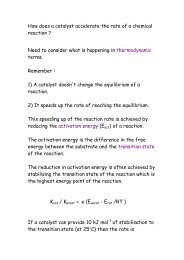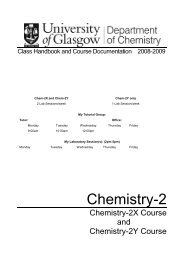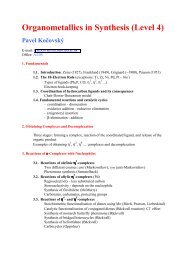chem3 handbook 07-08 1st Sept 2007 - University of Glasgow
chem3 handbook 07-08 1st Sept 2007 - University of Glasgow
chem3 handbook 07-08 1st Sept 2007 - University of Glasgow
You also want an ePaper? Increase the reach of your titles
YUMPU automatically turns print PDFs into web optimized ePapers that Google loves.
Department <strong>of</strong> Chemistry<br />
Chemistry Level 3<br />
Class Handbook<br />
20<strong>07</strong>-20<strong>08</strong><br />
Course Head: Dr Beth Paschke Room A5-20<br />
Course Secretary: Mrs Ruth Thomson Room A4-04<br />
1
Essential Information<br />
Class Head: Dr Beth Paschke<br />
Deputy Class Head: Dr. David Lennon<br />
Room A5-20 Room B3-15<br />
0141 330 6057 0141 330 4372<br />
bethpas@chem.gla.ac.uk<br />
davidle@chem.gla.ac.uk<br />
Class Head Chemical Physics: Dr Malcolm Kadodwala<br />
Room A3-15<br />
0141 330 4380<br />
malcolmk@chem.gla.ac.uk<br />
Class Head Chemistry with Forensic Studies: Dr Mike Jarvis<br />
Room C5-04<br />
0141 330 4653<br />
mikej@chem.gla.ac.uk<br />
Class Secretary: Mrs Ruth Thomson<br />
Room A4-04<br />
0141 330 8618<br />
rutha@chem.gla.ac.uk<br />
Organic Chemistry<br />
Inorganic Chemistry<br />
Physical Chemistry<br />
Laboratories<br />
Coordinator<br />
Dr Andrei Malkov<br />
Pr<strong>of</strong> Duncan Gregory<br />
Dr Adrian Lapthorn<br />
Tutorials<br />
Organic<br />
Inorganic<br />
Physical<br />
Coordinator<br />
Dr Andy Sutherland<br />
Dr Mark Murrie<br />
Dr Adrian Lapthorn<br />
MSci Placement Coordinator<br />
MSci Essay Coordinator<br />
Final Year Project Coordinator<br />
Dr Graeme Cooke<br />
Dr Daniel Price<br />
Dr Mark Murrie<br />
2
LEVEL-3 CHEMISTRY SESSION 20<strong>07</strong> - 20<strong>08</strong><br />
The class head is Dr Beth Paschke, Room A5-20, e-mail bethpas@chem.gla.ac.uk, Tel: 0141-330-<br />
6057 (direct). You are welcome to contact Dr Paschke at any time about any aspect <strong>of</strong> the course,<br />
either directly or through the course secretary, Ruth (Room A4-04, Tel. 0141 330-8618).<br />
This booklet contains most <strong>of</strong> the course information you will need at the start <strong>of</strong> the session.<br />
However, you should get into the habit <strong>of</strong> checking the class notice boards frequently for course<br />
announcements. One notice board is located on the ground floor near the porter’s box; however, the<br />
one on Level-4 near the entrance to the Main Lecture Theatre is updated more frequently.<br />
WHAT MAKES UP THE COURSE?<br />
Lectures are normally held in the Carnegie Lecture Theatre but a few courses may be given in other<br />
locations. Check the timetable to find out where and when each course is held. The content <strong>of</strong> each<br />
course is described in detail later in this <strong>handbook</strong>. Attendance at Alchemist Club talks and local<br />
section RSC lectures, Thursdays 4pm, is also strongly encouraged.<br />
Tutorials in organic chemistry are held weekly, on Wednesdays at 10 am. Physical and inorganic<br />
tutorials are held in alternate weeks, either on Monday or Thursday, normally at 10am. The names <strong>of</strong><br />
your tutors in organic, physical and inorganic chemistry and times <strong>of</strong> tutorials will be posted on the<br />
class notice board during week 1. Tutors may sometimes have to reschedule a tutorial. Check class<br />
notice boards regularly for news <strong>of</strong> such changes.<br />
The tutorial system is a major part <strong>of</strong> the Chem-3 learning process. To understand the coursework<br />
properly and to do well in the degree examination you must hand in assigned work before each<br />
tutorial and attend the tutorial itself. There is a direct correlation between exam results and tutorial<br />
attendance. Most students find the tutorials difficult – they are meant to be! Set aside enough time to<br />
tackle them.<br />
Your tutor will:<br />
** Attendance and the completion <strong>of</strong> work for tutorials is compulsory **<br />
1. Mark and assign a nominal grade reflecting the quality <strong>of</strong> the work you handed in (grades<br />
A-E).<br />
2. Record your attendance.<br />
3. Pass a record <strong>of</strong> your attendance and grades to the class secretary (Ruth Thomson).<br />
Note that tutorial grades will not contribute to the end <strong>of</strong> year mark. Students who have not handed<br />
in written work must still attend tutorials to gain a positive record <strong>of</strong> attendance.<br />
The class head will monitor your commitment to the course and factor that into an evaluation <strong>of</strong> your<br />
performance in the class exam (Week 13). Persistent absentees will be asked to explain their<br />
behaviour to Dr Paschke.<br />
Workshops give you practical instruction in Organic Spectroscopy and form part <strong>of</strong> the Organic<br />
Laboratory. A workshop on Inorganic NMR (Dr Farrugia) forms part <strong>of</strong> the Inorganic Laboratory.<br />
3
Laboratories<br />
Organic weeks 2 - 8 Monday, Tuesday, Wednesday and Thursday.<br />
Inorganic weeks 9 - 12 & 14 - 16 Monday, Tuesday, Wednesday and Thursday.<br />
Physical weeks 18 - 23 Monday, Tuesday and Wednesday.<br />
You should start your laboratory work at 1pm. The laboratories normally close at 5pm.<br />
Your laboratory mark counts toward the grade you will receive in the degree examination.<br />
Information Technology courses<br />
The Chemistry Department runs several clusters <strong>of</strong> computers for 3rd and 4th year undergraduate use.<br />
To use these you need a user name and password, which will be provided by Mr Mackay, Room A5-<br />
09a. We <strong>of</strong>fer a series <strong>of</strong> courses to help you use these computers. Attendance is not compulsory and<br />
the courses will only be run if there is a demand for them. Some <strong>of</strong> the topics on <strong>of</strong>fer are:<br />
• PCs for beginners<br />
• Scientific calculations with EXCEL<br />
• Word processing using Micros<strong>of</strong>t Word<br />
• Using the Internet<br />
• Using electronic mail<br />
• Drawing molecules using Chem Draw<br />
Other topics can be covered if there is sufficient student demand. The teaching laboratories,<br />
especially the Physical Chemistry Laboratory, will also help you develop your ability to apply<br />
modern computer technology to chemical problems.<br />
SUPPLEMENTARY COURSE<br />
Chem 3H are expected to attend a short lecture on “Ethics” (S3c) given by Pr<strong>of</strong>essor Cooper on<br />
Friday 2nd November - 13.30 - 14.45 (Gannochy Room, Wolfson Medical Building) for 3H and<br />
15.45 - 17.00 (Conference Room) for 3M.<br />
Course S2 (Procter & Gamble) may have extra spaces to accommodate 3H students.<br />
information will be available at registration.<br />
Further<br />
EXAMINATIONS<br />
To help you prepare for the degree examination, a class examination, consisting <strong>of</strong> three papers, will<br />
be held in week 13.<br />
The Degree examinations are held in May and August.<br />
10% <strong>of</strong> your May performance will be carried forward to contribute to your Final Degree<br />
examinations in Level 4. Note that normally you may take a molecular model kit but not textbooks<br />
or periodic tables into third- or fourth-year examinations. Occasionally, you may be allowed to take a<br />
specific textbook into an examination. You will be told well in advance if this is so.<br />
The Level-3 Degree examination is based on three three-hour written papers. These papers<br />
contribute 85% to your final grade for the year. The other 15% comes from assessment <strong>of</strong> your<br />
practical work throughout the session. For Masters students the breakdown is: written papers 80%;<br />
lab assessment 15%; MSci essay 5%.<br />
The course is made up <strong>of</strong> 18 lecture courses whose descriptions start on page 12. In the Degree<br />
Examination, Paper 1 will be based on units O1 - O6, Paper 2 on I1 - I6 and Paper 3 on units P1 - P6.<br />
4
STUDENT PROGRESS<br />
To attain credit for the Level-3 course you must:<br />
(a) regularly attend all meetings <strong>of</strong> the class - lectures, tutorials, workshops and laboratories<br />
and<br />
(b) perform acceptably in the class and degree examinations and in the laboratory<br />
Dr Paschke will be happy to discuss points <strong>of</strong> concern with you in confidence at any time. However,<br />
you should also visit your adviser <strong>of</strong> studies regularly to discuss how you are coping.<br />
PROGRESSION TO LEVEL 4 & REQUIREMENTS FOR B.Sc. (Designated) DEGREES<br />
Full details can be found in the 20<strong>07</strong>-20<strong>08</strong> <strong>University</strong> Calendar (Science section)<br />
http://www.gla.ac.uk/reference/calendar20<strong>07</strong>-20<strong>08</strong>.html and in the Undergraduate Course Catalogue<br />
20<strong>07</strong>-20<strong>08</strong>. Both booklets can be obtained from the Science Office, Level 3, Boyd Orr Building. All<br />
students should check with their adviser <strong>of</strong> studies on how the regulations apply in their particular<br />
case.<br />
To enter Level 4H you must complete the Level-3H course (120 credits), normally at grade D or<br />
above. You must also have completed other courses (not including Level-3 chemistry) totalling at<br />
least 240 credits with a grade point average <strong>of</strong> at least 11 - you will have already met this requirement<br />
to gain admission to Level 3H. The final decision about progression to Level 4H is made by the<br />
Head <strong>of</strong> Department. Note that a grade-D performance at Level 4 corresponds to third-class Honours.<br />
To graduate from Level 3 with a B.Sc. (Designated) degree you must have:<br />
(a)<br />
completed courses totalling at least 360 credits (including those obtained at Level 3) with a<br />
grade point average <strong>of</strong> at least 10 and either<br />
(b) attained either at least 80 credits with a grade point average <strong>of</strong> at least 10 or at least 120<br />
credits with a grade point average <strong>of</strong> at least 8 at Level 3 in the Designated subject or<br />
(c)<br />
where the Designated subject is a combination <strong>of</strong> two subjects, attained at least 60 credits<br />
with a grade point average <strong>of</strong> at least 8 in each <strong>of</strong> these Level-3 subjects.<br />
A student who meets or exceeds the minimum entry requirements <strong>of</strong> a Level-3H course and who<br />
completes it with at least a grade E will normally be able to graduate with a B.Sc. (Designated)<br />
degree.<br />
The B.Sc. (Designated) degree may be awarded with merit if a grade point average <strong>of</strong> at least 12 is<br />
attained or with distinction if a grade point average <strong>of</strong> at least 14 is attained, both overall and in the<br />
Designated subject.<br />
5
ILLNESS AND ABSENCE FROM CLASSES<br />
If you are unable to attend classes, please contact Dr Paschke as soon as possible to explain the<br />
reasons for your absence and to decide if a letter or a self-certificate or a medical certificate should be<br />
submitted. The particular situations, which require submission <strong>of</strong> a certificate, are set out in the<br />
current version <strong>of</strong> the booklet The Registry. A Student Guide, available from the Science Office.<br />
If you believe that your performance in the course has been adversely affected for reasons, which you<br />
wish to draw to the attention <strong>of</strong> the Board <strong>of</strong> Examiners, it is essential that you write to Dr Paschke<br />
to inform her <strong>of</strong> the circumstances.<br />
POLICY ON SUMMATIVE ASSESSMENT<br />
All feedback on coursework used in assessment, including mid-year class exam/class test marks and<br />
laboratory grades, is strictly provisional for your guidance only, and is subject to ratification by the<br />
Board <strong>of</strong> Examiners and external examiners at the end <strong>of</strong> the academic year. You must retain all<br />
copies <strong>of</strong> assessed work (lab notebooks, exam scripts, etc.) and have them available for inspection by<br />
the examiners if requested at the end <strong>of</strong> the year. You will be given reasonable advance warning<br />
should this be required.<br />
PLAGIARISM<br />
Plagiarism is the submission <strong>of</strong> someone else’s work as one’s own without acknowledgement. As<br />
recent cases have shown, it is regarded as a serious <strong>of</strong>fence against <strong>University</strong> discipline. You must<br />
read the Senate-approved Plagiarism Statement, which explains the policy <strong>of</strong> the <strong>University</strong>.<br />
Degrees from <strong>Glasgow</strong> <strong>University</strong> recognise personal achievement. It follows that any work you<br />
submit must be your own. It may be proper, and even desirable, to include words, data or ideas taken<br />
from books or articles, the world-wide web or even from other students in work you submit for<br />
assessment. But you must make it completely clear what is yours and what you have taken from<br />
others. If you copy someone else’s words you must enclose them with quotation marks. You should<br />
also give a verifiable reference: for example F.A. Cotton and G. Wilkinson, Advanced Inorganic<br />
Chemistry, Fifth Edition, John Wiley & Sons, New York, 1988, page 1219 or J. Smith, Level-3<br />
Inorganic Laboratory Report, April 2 nd , 2000.<br />
This regulation applies to all work submitted for assessment, including lab reports, class tests and<br />
research projects unless you have specifically been told otherwise, for example in the case <strong>of</strong> a group<br />
project or when a number <strong>of</strong> students share experimental data.<br />
UNIVERSITY OF GLASGOW<br />
Plagiarism Statement<br />
See <strong>University</strong> Guidelines at the following address<br />
www.law.gla.ac.uk/Students/Plagiarism.html<br />
6
THE CHEMISTRY BRANCH LIBRARY<br />
Our librarian, Denise Currie, has a selection <strong>of</strong> recommended textbooks, which are available for short term<br />
loan and can also advise students on how to use the extensive collection <strong>of</strong> chemical literature held in the<br />
library.<br />
CHEMISTRY-3H: RECOMMENDED TEXTBOOKS FOR 20<strong>07</strong>-20<strong>08</strong><br />
(a)<br />
ESSENTIAL PURCHASES. Level-4 Students will already have most <strong>of</strong> these books.<br />
• Molecular models, table molecular model kit such as Organic/Inorganic Orbit kit, Orbit Molecular<br />
Building System, Cochranes <strong>of</strong> Oxford Ltd, Leafield, Oxford OX8 5NT, £17.68.<br />
• Inorganic Chemistry*, P F Shriver, P W Atkins and C H Langford, OUP, 4th Edition, 2006, £37.99<br />
• Spectroscopic Methods in Organic Chemistry, D H Williams and I Fleming, McGraw-Hill, 5th<br />
Edition Revised, £39.99.<br />
• Organic Chemistry, J Clayden, N Greeves, S Warren and P Wothers, OUP, £37.99.<br />
• Atkins’ Physical Chemistry**, P W Atkins and J De Paula, 8 th Edition, 2006, OUP, £39.99<br />
• Alternative texts, if purchased during 2 nd Year;<br />
*Inorganic Chemistry, C E Houscr<strong>of</strong>t and A.G Sharpe, Prentice Hall, 2 nd Edition, 2004,£42-99.<br />
** Physical Chemistry, R A Alberty and R J Silbey, John Wiley, 4th Edition, £37.95.<br />
(b)<br />
BOOKS RECOMMENDED FOR CONSULTATION – available in the Chemistry Branch<br />
Library<br />
• Introduction to Molecular Symmetry, J S Ogden, Oxford Chemistry Primers.<br />
• Molecular Quantum Mechanics, P W Atkins and R S Friedman, 4th Edition, OUP, 2004.<br />
• Quantum Mechanics in Chemistry, J Simons and J Nichols, OUP.<br />
• Fundamentals <strong>of</strong> Molecular Spectroscopy, C N Banwell, McGraw-Hill, 4th Edition.<br />
• Molecular Spectroscopy, J M Brown, Oxford Chemistry Primers.<br />
• Photochemistry, C E Wayne & R P Wayne, Oxford Chemistry Primers.<br />
• Crystal Structure Determination, W Clegg, Oxford Chemistry Primers.<br />
• Textbook for Organic Synthesis: The Disconnection Approach, S Warren, Wiley.<br />
• Reactive Intermediates, C J Moody and G H Whitham, Oxford Chemistry Primers.<br />
• Stereoelectronic Effects, A J Kirby, Oxford Chemistry Primers.<br />
• Selectivity in Organic Synthesis, R S Ward, Wiley 1999.<br />
• Organic Stereaochemistry, M J T Robinson, Oxford Chemistry Primers.<br />
• Stereochemistry, Tutorial Chemistry Text, D G Morris, RSC.<br />
• Basic Solid State Chemistry, Second Edition, A R West, John Wiley.<br />
• Introduction to Organometallics, C Elschenbroich & A Salzer, Cambridge.<br />
• Solid state Chemistry, an Introduction, L Smart & E Moore, CRC Press.<br />
• Principles and Practice <strong>of</strong> Heterogeneous Catalysis, J M Thomas & W J Thomas,Weinheim,1996.<br />
You will be notified <strong>of</strong> any additional references by your lecturer.<br />
7
Chemistry and Medicinal Chemistry 3M and 3H<br />
20<strong>07</strong> - 20<strong>08</strong><br />
semester 2<br />
semester 1<br />
Week 0 1 2 3 4 5 6 7 8 9 10 11 12 13 14 15 16 17 18 19 20 21 22 23 24 25 26<br />
Begins<br />
Mon<br />
Tues<br />
Wed<br />
Thur<br />
Fri<br />
17<br />
Sep<br />
24<br />
Sep<br />
01<br />
Oct<br />
<strong>08</strong><br />
Oct<br />
15<br />
Oct<br />
22<br />
Oct<br />
29Oct<br />
05<br />
Nov<br />
12<br />
Nov<br />
19<br />
Nov<br />
26<br />
Nov<br />
9 I1 I1 I1 I1 I3 I3 I3 I3 I5/O7 I5/O7 I5/O7 I5/O7<br />
03<br />
Dec<br />
10 IT PT IT PT IT PT IT PT IT PT IT PT IT PT IT PT IT PT IT PT IT<br />
10<br />
Dec<br />
11 O1 O1 O1 O2 O2 O2 O2 O6 O6 O6 O6<br />
1 OL OL OL OL OL Co Pr IL IL IL IL IL IL IL PL PL PL PL PL<br />
9 P1 P1 P1 P1 I3 I3 I3 I3 P6 P6<br />
10 P4 P4 P4 P4 O5 O5 O5 O6 O6<br />
11 enroll I1 I1 I1 I1 I2 I2 O3 O3 O3 O3 I4 I4 I4 I4<br />
1 SW OL OL OL OL OL Co Pr IL IL IL IL IL IL IL PL PL PL PL PL PL<br />
9 P1 P1 P1 P1 I4 I4 I4 I4 I5/<strong>07</strong> I5/<strong>07</strong> I5/<strong>07</strong> I5/<strong>07</strong><br />
10 OT OT OT OT OT OT OT OT OT OT OT OT OT OT OT OT OT OT OT OT OT<br />
11 O1 I2 I2 O4 O4 O4 O4 O5 O5 O5 I6 I6 I6 I6<br />
1 SW OL OL OL OL OL Co Pr IL IL IL IL IL IL IL PL PL PL PL PL PL<br />
9 P2 P2 P2 P2 P3 P3 P3 P3 P5 P5 P5 P5 P6 P6 P6 I6 I6 I6 I6<br />
10 IT PT IT PT IT PT IT PT IT PT IT PT IT PT IT PT IT PT IT PT IT<br />
11 I2 I2 I2 I2 O3 O3 O3 O3 O4 O4 O4 O4 O6 O6<br />
1 SW OL OL OL OL OL Co Pr IL IL IL IL IL IL IL PL PL PL PL PL PL<br />
9 P2 P2 P2 P2 P5 P5 P5 P5 P6 P6 P6<br />
Holiday<br />
Holiday<br />
10 P3 P3 P3 P3 O5 O5<br />
11 O1 O1 O1 O1 O2 O2 O2 O2 P4 P4 P4 P4<br />
1 Pl.Talks Pl.talks S2 S3a-c S6a,b S4 S5 S7 S8a,b Assess Assess S9a,b<br />
<strong>07</strong><br />
Jan<br />
Exams<br />
Exams Exams Exams Exams<br />
OL = Organic lab (Co = coops, Pr = coop presentations) OT = Organic Tutorials (21)<br />
IL = inorganic lab IT = Inorganic Tutorials (10) x2)<br />
PL = physical lab PT = Physical Tutorials (10) x2)<br />
14<br />
Jan<br />
21<br />
Jan<br />
28<br />
Jan<br />
04<br />
Feb<br />
11<br />
Feb<br />
18<br />
Feb<br />
25<br />
Feb<br />
03<br />
Mar<br />
10<br />
Mar<br />
<strong>07</strong><br />
Apr<br />
14<br />
Apr<br />
21<br />
Apr<br />
28<br />
Apr<br />
Lec - Organic Lec - Inorganic Lec - Physical<br />
O1 Organic Synthesis 1 (AS) I1 Coordination Chemistry (MM) P1 Biomolecular Interactions (AL)<br />
O2 Mechanistic Organic Chemistry (RCH) I2 Main Group Chemistry (DP) P2 Quantum Mechanics/Symmetry (JM)<br />
O3 Organic Synthesis 2 (SC) I3 Heterogeneous Catalysis (SDJ) P3 Kinetics (DL)<br />
O4 Controlling Stereochemistry (AM) I4 Organometallic Chemistry (LF) P4 Spectroscopy (SW)<br />
O5 Sugars and Steroids (PK) I5 Solid State Chemistry (JH) P5 Diffraction (AL)<br />
O6 Reactive Intermediates (tba) I6 Bio-inorganic Chemistry (LC) P6 Photochemistry (MK)<br />
O7<br />
(CMC only) Medicinal chemistry (RM) replaces I5<br />
S = Supplementary courses - mainly for MSci class (See Supplementary Timetable)<br />
SW = Spectroscopy Workshop<br />
8<br />
Lectures normally in Carnegie Lecture Theatre
SUPPLEMENTARY TIMETABLE<br />
20<strong>07</strong>-20<strong>08</strong><br />
ADDITIONS To The BSc PROGRAMME<br />
Frontiers <strong>of</strong> Chemistry:<br />
Week Lecturer Title Time<br />
1 GC S1 Applying for Placements **<br />
2 MSci-4 Placement Talks* 14.00-17.00<br />
3 MSci-4 Placement Talks* 14.00-17.00<br />
4† S2 Procter & Gamble - Transferable skills<br />
workshop<br />
13.00-15.00<br />
6 Greig Sinclair S3a Intellectual Property (R&E) 14.00-15.00<br />
6 DP S3b Introduction to Inorganic Presentations 15.00-15.30<br />
6‡ AC S3c Ethics 15.45-17.00<br />
9 AS S6a Biotransformations 1 13.30-15.30<br />
9 AS S6b Biotransformations 2 16.00-17.00<br />
10 DP & Inorg Staff S4 Inorganic Chemistry Presentations 13.30-15.30<br />
11 DP & Inorg Staff S5 Inorganic Chemistry Presentations 13.30-15.30<br />
14† DP S7 Essay Writing 13.30-14.30<br />
15 AL S8a Protein Structure 1 13.30-15.30<br />
15 CG/CW S8b Frontiers <strong>of</strong> Crystallography 1 16.00-17.00<br />
16 BP/DL Student Assessment Interview 13.00-17.00<br />
17 BP/DL Student Assessment Interview 13.00-17.00<br />
18 CG/CW S9a Frontiers <strong>of</strong> Crystallography 2 13.30-15.30<br />
18 AL S9b Protein Structure 2 16.00-17.00<br />
Most classes are in the conference room unless otherwise instructed.<br />
Those marked * are in the Physical Lecture Theatre (B4-06).<br />
** Dr. Cooke will organise appointments with students individually to discuss placements.<br />
† Optional for 3H<br />
‡ Compulsory for 3H. To be given at 13.30 (Gannochy Room, Wolfson Medical Building )<br />
9
Title:<br />
Lecturer(s):<br />
Organic Laboratory<br />
Dr Andrei Malkov<br />
Aims:<br />
To develop skill in practical organic chemistry and in the oral and written presentation <strong>of</strong><br />
scientific results. To gain experience <strong>of</strong> group work.<br />
Objectives:<br />
Synthetic experiments and structure determinations:<br />
1. To develop skills in the practical techniques <strong>of</strong> organic chemistry.<br />
2. To practise mechanistic interpretation, and to understand reaction types and the factors<br />
affecting reaction outcomes and yields.<br />
3. To interpret spectra (IR, 1 H and 13 C NMR).<br />
4. To use the chemical literature.<br />
5. To write clear, informative and referenced reports and to defend conclusions orally.<br />
The co-operative investigation:<br />
1. To develop skills <strong>of</strong> group working, co-operation and lateral thinking.<br />
2. To develop skills <strong>of</strong> literature searching, including the use <strong>of</strong> databases.<br />
3. To develop skills <strong>of</strong> word processing and computer drawing.<br />
4. To develop skills <strong>of</strong> oral discussion.<br />
5. To develop skills <strong>of</strong> oral presentation to a large audience.<br />
6. To <strong>of</strong>fer a challenge and invite open-ended interpretation, correlation and deeper study.<br />
Outline:<br />
The laboratory will run from week 2 to week 8 inclusive. It will be open on Mondays and<br />
Thursdays from 1 p.m. until 4 p.m. and Tuesdays and Wednesdays from 1 p.m. until 5<br />
p.m., i.e. 14 hours per week.<br />
• During these periods, each student will individually carry out 5 experiments and will<br />
determine the structures <strong>of</strong> two unknown compounds using spectroscopic methods.<br />
• In the last two weeks <strong>of</strong> the laboratory, weeks 7 and 8 a co-operative investigation takes<br />
place. A group <strong>of</strong> students working as a team will be given a co-operative assignment.<br />
These range from purely paper exercises to practical investigations carried out in the<br />
laboratory. A named member <strong>of</strong> staff advises each group and assesses their effort, report<br />
and understanding. Each group will present their conclusions to the whole class and<br />
answer questions during the CO-OP presentations at the end <strong>of</strong> week 8.<br />
• Prizes will be awarded for the best group presentation.<br />
Except for the oral presentation, all work in the laboratory is assessed and contributes<br />
toward the grade awarded in the degree examination. Material covered in the<br />
laboratories is examinable.<br />
10
Code:<br />
O1<br />
Title: Organic Synthesis 1<br />
Lecturer(s):<br />
Aims:<br />
Dr A Sutherland<br />
To revise and expand the understanding <strong>of</strong> synthetic transformations and to apply these<br />
concepts to the synthesis <strong>of</strong> multifunctional organic compounds. The fundamentals <strong>of</strong><br />
retrosynthetic analysis will also be introduced.<br />
Objectives:<br />
1. To study several different approaches for the synthesis <strong>of</strong> carbon/carbon double bonds<br />
including aldol condensations, eliminations and phosphorous based reactions.<br />
2. Discuss the broad reactivity <strong>of</strong> alkenes and highlight important reactions such as, addition,<br />
ozonolysis, epoxidation, hydroboration and oxidation.<br />
3. Appreciate the different methods <strong>of</strong> formation <strong>of</strong> carbon / carbon single bonds.<br />
4. Be able to carry out functional group interconversions <strong>of</strong> all the major functional groups.<br />
5. Understand how chemoselectivity can be used for selective functional group manipulation in<br />
both oxidations and reductions.<br />
6. Apply the rules <strong>of</strong> retrosynthetic analysis to target compounds and to be able design synthetic<br />
routes to these compounds.<br />
Outline:<br />
Synthesis <strong>of</strong> Alkenes:<br />
• revise Aldol condensations and eliminations reactions;<br />
• introduce the Wittig, Wadsworth-Emmons and Horner reactions (kinetic vs<br />
thermodynamic control);<br />
• reduction <strong>of</strong> alkynes.<br />
Reactivity <strong>of</strong> Alkenes:<br />
• revise addition reactions;<br />
• ozonolysis;<br />
• dihydroxylation;<br />
• epoxidation and subsequent opening;<br />
• hydroboration;<br />
• Diels-Alder reaction;<br />
• Oxidation using transition metals.<br />
Synthesis <strong>of</strong> C-C single bonds:<br />
• organometallic reagents;<br />
• stabilised anions such as enolates;<br />
• nitroalkanes;<br />
• imines/enamines.<br />
Functional group interconversions:<br />
• oxidation <strong>of</strong> alcohols, aldehydes and ketones;<br />
• Baeyer-Villiger oxidation <strong>of</strong> ketones;<br />
• Activation <strong>of</strong> alcohols and subsequent reaction with C-, N-, O-, S- and P-nucleophiles;<br />
• Chemoselective reduction <strong>of</strong> carbonyl functional groups.<br />
Case Study:<br />
• Retrosynthetic analysis <strong>of</strong> a natural product and then design <strong>of</strong> a forward synthesis using<br />
some <strong>of</strong> the aforementioned techniques.<br />
11
Code:<br />
Title:<br />
Lecturer(s):<br />
Aims:<br />
Objectives:<br />
O2<br />
Mechanistic Organic Chemistry<br />
Dr R C Hartley<br />
To explain the factors that determine what products are formed in a reaction and the<br />
mechanisms and rates <strong>of</strong> formation; to introduce ways <strong>of</strong> determining mechanism and<br />
optimising reaction conditions.<br />
1. Understand reaction co-ordinate diagrams, microscopic reversibility, Hammond postulate,<br />
kinetic and thermodynamic control, and be able to use ∆G o =-RTlnK and the Arrhenius<br />
equation.<br />
2. Draw curly arrow mechanisms for a variety <strong>of</strong> reaction types including substitutions at<br />
saturated centres (S N 1, S N 2 and intramolecular displacements) by various nucleophiles<br />
(including enolates), eliminations to form alkenes (E1, E2 and E1cB), and rearrangements.<br />
3. Understand the importance <strong>of</strong> orbital overlap (particularly in E2 reactions) and conjugation<br />
and so predict and explain the shape, relative thermodynamic stability and reactivity <strong>of</strong><br />
molecules.<br />
4. Recognise and explain steric and stereoelectronic effects and so predict and explain the shape,<br />
relative thermodynamic stability and reactivity <strong>of</strong> molecules.<br />
5. Explain the role <strong>of</strong> orbital and electrostatic interactions in S N 2 reactions.<br />
6. Understand the importance <strong>of</strong> proximity and entropic effects, and recognise and give curly<br />
arrow mechanisms for neighbouring group participation.<br />
7. Derive and carry out calculations involving rate equations and effective molarity.<br />
8. Understand how temperature, concentration, solvent, and catalysts (in particular nucleophilic)<br />
affect the position <strong>of</strong> equilibrium and the rate <strong>of</strong> reactions (in particular substitutions at<br />
saturated centres and eliminations) and suggest suitable conditions for proposed reactions.<br />
9. Describe and suggest methods for determining mechanisms, and be able to interpret<br />
mechanistic evidence.<br />
Outline:<br />
• Revision <strong>of</strong> mechanisms <strong>of</strong> substitution at a saturated centre, elimination, and acyl<br />
substitution;<br />
• Reaction co-ordinates, thermodynamics and kinetics (including control), microscopic<br />
reversibility, Hammond postulate;<br />
• Conjugation effects (aromatic substitution), orbital alignment (eliminations and<br />
migrations), electronic strain, other stereoelectronic effects (hyperconjugation), HOMO-<br />
LUMO and electrostatic interactions (hard/s<strong>of</strong>t nucleophiles), steric effects, entropic<br />
effects, proximity effects (ring size, neighbouring group participation, anchimeric<br />
assistance);<br />
• Variables including temperature, concentration, solvent, catalysts (nucleophilic);<br />
• Determining mechanism <strong>of</strong> reaction through structural evidence (substrates, products,<br />
stereochemistry), kinetic evidence (order <strong>of</strong> reaction, rate changes), and structural probes.<br />
12
Code:<br />
O3<br />
Title: Organic Synthesis 2<br />
Lecturer(s):<br />
Aims:<br />
Pr<strong>of</strong>essor J Stephen Clark<br />
To develop the concept <strong>of</strong> retrosynthetic analysis and synthetic planning based on functional<br />
group transformation and normal carbonyl reactivity.<br />
Objectives:<br />
By the end <strong>of</strong> the course, you should be able to:<br />
1. Understand and use the concept <strong>of</strong> “synthon” and “disconnection”.<br />
2. Apply retrosynthetic analysis to a variety <strong>of</strong> functionalised carbonyl compounds in terms <strong>of</strong> α-<br />
substitution and 1,3- and 1,5-difunctionalised compounds.<br />
3. Apply in synthesis the effect <strong>of</strong> stabilisation <strong>of</strong> enolates derived from 1,3-dicarbonyl<br />
compounds<br />
4. Appreciate kinetic and thermodynamic control in enolate formation.<br />
5. Understand the use <strong>of</strong> trimethylsilyl enol ethers as enolate anion precursors for α-alkylation.<br />
6. Understand the α-alkylation <strong>of</strong> enamines and imines.<br />
7. Apply Wittig and Mannich reaction and selenoxide formation as synthetic tools to generate<br />
α,β-unsaturated compounds.<br />
8. Understand Michael addition <strong>of</strong> enolates to generate 1,5-dicarbonyl compounds.<br />
9. Appreciate the value <strong>of</strong> organocuprates in conjugate addition to α,β-unsaturated carbonyl<br />
compounds and in allylic substitution.<br />
Outline:<br />
• Synthetic strategies based on one-group disconnection (simple alcohols, olefins and<br />
ketones) and two-group disconnections (1,3- and 1,5-dioxygenated skeletons);<br />
• functional group transformations;<br />
• Michael addition and cuprate addition.<br />
13
Code:<br />
Title:<br />
Lecturer(s):<br />
O4<br />
Controlling Stereochemistry<br />
Dr A Malkov<br />
Aims: To introduce the principles <strong>of</strong> diasterereoselective and enantioselective synthesis. To<br />
describe methods <strong>of</strong> measuring enantio- and diastereo-isomeric ratios. To demonstrate the<br />
importance <strong>of</strong> six-membered rings (whose properties will be revised) and conformational<br />
rigidity for conformational control, particularly in transition states.<br />
Objectives:<br />
By the end <strong>of</strong> the course, students should be able to:<br />
1. Understand and use accurately proper stereochemical conventions for drawing molecules<br />
which owe their chirality to a chiral centre, a chiral axis or a chiral plane.<br />
2. Understand the significance <strong>of</strong> enantiotopic and diastereotopic groups and faces.<br />
Recognise and provide examples <strong>of</strong> enantioselective and diastereoselective reactions.<br />
Rationalise selectivity in terms <strong>of</strong> diastereomeric transition states, which have different<br />
energies.<br />
3. Be familiar with chirally modified reagents including BINAL-H and chiral boranes, and<br />
explain their modes <strong>of</strong> action in straightforward cases. Appreciate the importance <strong>of</strong> both<br />
steric and stereoelectronic factors in stereocontrol.<br />
4. Define and use appropriately the terms enantiomeric excess (ee) and enantiomeric ratio (ee).<br />
5. Suggest analytical methods (spectroscopic and chromatographic) for measuring isomeric<br />
ratios. Understand why determination <strong>of</strong> diastereomeric ratio is more straightforward than<br />
that <strong>of</strong> ee. Appreciate that identification <strong>of</strong> the major isomer may not be straightforward but<br />
may be achieved by correlation or by crystallography.<br />
6. Apply Cram’s rule in nucleophilic addition to α-chiral carbonyl compounds, and explain<br />
Cram’s rule in terms <strong>of</strong> the Felkin-Anh rationalisation.<br />
7. Understand what is meant by chelation control in diastereoselective additions to α- and β-<br />
chiral alkoxy ketones and related compounds and explain the observed selectivity in such<br />
reactions.<br />
8. Appreciate the importance <strong>of</strong> conformational rigidity in controlling stereo- and sometimes<br />
regio-selectivity. Illustrate and explain the course <strong>of</strong> reactions on cyclohexenes and related<br />
compounds.<br />
9. Apply the above in unfamiliar situations.<br />
Outline:<br />
• Introduction. Definitions, terms and conventions; drawing three-dimensional molecules;<br />
chirality without a chiral centre;<br />
• Reactions on achiral compounds. Achiral ketone + NaBH 4 ; topism and prochirality;<br />
importance <strong>of</strong> asymmetric synthesis; enantiotopic faces; asymmetric reduction <strong>of</strong> prochiral<br />
ketones; (Ipc) 2 BCl and Alpine-borane TM and their mode <strong>of</strong> action; enantiotopic groups;<br />
desymmetrisation and use <strong>of</strong> enzymes;<br />
• Measuring the outcome. Enantiomeric excess; optical methods & their drawbacks;<br />
physical separation <strong>of</strong> enantiomers; resolution; chiral chromatography; spectroscopic<br />
methods; NMR on chiral compounds; chiral derivatising agents, Mosher’s acid chloride<br />
etc.; determination <strong>of</strong> absolute configuration;<br />
14
• Reactions on chiral compounds. Nucleophilic addition to unfunctionalised α-chiral<br />
ketones; threo/erythro, syn/anti and l/u nomenclature; Cram’s rule; Felkin-Anh<br />
rationalisation; chelation controlled attack; α-chiral, α-alkoxy carbonyl compounds; ester,<br />
amine and silyloxy substituents; β-chiral, β-alkoxy carbonyl compounds;<br />
• Six-membered rings. Reminder <strong>of</strong> chair conformations; half chair conformations <strong>of</strong><br />
cyclohexene and its oxide; axial alkylation <strong>of</strong> 6-ring cyclic enolates; ring opening <strong>of</strong><br />
cyclohexene oxides and related compounds; asymmetric reduction <strong>of</strong> prochiral ketones;<br />
BINAL-H and its mode <strong>of</strong> action; electronic factors in stereoselectivity.<br />
Recommended Reading<br />
Clayden, Greeves, Warren & Wothers. Key phrases to look up: chirality; prochirality; pro-R<br />
and pro-S; diastereoselectivity; stereoselective reactions; cyclohexanes and cyclohexenes,<br />
conformations <strong>of</strong>; axial attack on cyclohexenes; hydroboration.<br />
15
Code:<br />
Title:<br />
Lecturer(s):<br />
Aims:<br />
O5<br />
Carbohydrate and Steroid Chemistry<br />
Pr<strong>of</strong>essor Pavel Kocovsky<br />
To provide a basic introduction to modern carbohydrate and steroid chemistry.<br />
Objectives:<br />
By the end <strong>of</strong> the course you should be able to:<br />
1. Discuss the linear and cyclic structure <strong>of</strong> carbohydrates and the ways in which these forms are<br />
represented.<br />
2. Study the anomeric and exo-anomeric effects, their electronic origins and their role in<br />
carbohydrate chemistry.<br />
3. Discuss the protecting group chemistry <strong>of</strong> carbohydrates.<br />
4. Examine glycosylation reactions and their mechanisms – directing and non-directing groups at<br />
C2, the effect <strong>of</strong> solvent etc.<br />
5. Learn different methods for glycosylation.<br />
6. Get familiar with examples <strong>of</strong> synthetic sequences in carbohydrate chemistry.<br />
7. Define the constitution and stereochemistry <strong>of</strong> the steroid skeleton.<br />
8. Get familiar with various types <strong>of</strong> steroids and their biological function, their contraceptive<br />
and anabolic effects, etc.<br />
9. Highlight the synthetic approach to steroid hormones and their analogues<br />
10. Get familiar with steroid glycosides and their function in treating heart insufficiency<br />
Outline:<br />
The course will examine the fundamentals <strong>of</strong> carbohydrate and steroid chemistry:<br />
• In the first part, the linear and cyclic structure <strong>of</strong> carbohydrates and the ways in which<br />
these forms are represented will be revised;<br />
• The anomeric and exo-anomeric effects, their electronic origins and their role in<br />
carbohydrate chemistry will be introduced;<br />
• The crucial importance <strong>of</strong> protecting groups in carbohydrate chemistry will next be<br />
discussed before the basics <strong>of</strong> the glycosylation reaction will be considered;<br />
• The advantages and disadvantages <strong>of</strong> various methods for glycosylation will then be<br />
examined;<br />
• In the second part, the course will focus on the steroid skeleton, the function <strong>of</strong> steroids in<br />
living organisms and the practical synthesis <strong>of</strong> selected representatives <strong>of</strong> the steroid<br />
realm;<br />
• The stereochemical issues, selective functionalization, and the role <strong>of</strong> protecting groups<br />
will also be examined.<br />
16
Code:<br />
Title:<br />
Lecturer(s):<br />
Aims:<br />
O6<br />
Reactive Intermediates<br />
To be confirmed<br />
To provide a basic introduction to modern synthetic chemistry using radicals and carbenes.<br />
Objectives:<br />
1. To discuss the structure and stability <strong>of</strong> radicals and to understand the principle <strong>of</strong> homolytic<br />
bond cleavage including how to draw radical mechanisms.<br />
2. To examine the many methods for initiating and mediating radical reactions and the reagents<br />
used.<br />
3. To examine chain reactions using tributyltin hydride and various functional group<br />
transformations using the reagent. (Barton-McCombie reaction, Reduction <strong>of</strong><br />
thiohydroxamate esters)<br />
4. To study radical cyclisation reactions. (Baldwin’s nomenclature).<br />
5. Electron-transfer reactions – use <strong>of</strong> dissolving metals, samarium(II) iodide and low-valent<br />
titanium reagents. (Birch reduction, ketyl-olefin cyclisations and pinacol couplings).<br />
6. To study the structure and properties <strong>of</strong> carbenes (including metallocarbenes and carbenoids).<br />
7. To examine the synthetically useful reactions <strong>of</strong> carbenes including, cyclopropanation,<br />
insertion and rearrangement reactions. (Simmons-Smith cyclopropanation, intramolecular<br />
cyclopropanation, the Wolff rearrangement (Arndt-Eistert homologation)).<br />
Outline:<br />
• The course will examine the properties and reactivities <strong>of</strong> important reactive<br />
intermediates, focussing on radicals and carbenes;<br />
• We will discuss the structure and stability <strong>of</strong> radicals and the principles <strong>of</strong> homolytic bond<br />
cleavage and radical mechanisms;<br />
• We will examine methods for initiating and mediating radical reactions, and the reagents<br />
used;<br />
• Chain reactions using tributyltin hydride and functional group transformations will be<br />
studied (Barton-McCombie, Reduction <strong>of</strong> thiohydroxamate esters) as will radical<br />
cyclisation reactions (Baldwin’s nomenclature);<br />
• Electron-transfer reactions using dissolving metals, samarium(II) iodide and low-valent<br />
titanium reagents will be discussed and the mechanism <strong>of</strong> reactions (Birch reduction <strong>of</strong><br />
aromatics, ketyl-olefin cyclisations and pinacol couplings) will be examined;<br />
• The structure and properties <strong>of</strong> carbenes (including metallocarbenes and carbenoids) and<br />
the synthetically useful reactions <strong>of</strong> carbenes including, cyclopropanation, insertion and<br />
rearrangement reactions will be taught (Simmons-Smith, intramolecular cyclopropanation,<br />
the Wolff rearrangement (as part <strong>of</strong> the Arndt-Eistert process)).<br />
17
Title:<br />
Lecturer(s):<br />
Inorganic Laboratory<br />
Pr<strong>of</strong>essor D Gregory<br />
Aims:<br />
To develop skills in practical inorganic chemistry and in oral and written presentation <strong>of</strong><br />
scientific results.<br />
Objectives:<br />
1. To develop skills in various practical techniques <strong>of</strong> inorganic and radio-chemistry including<br />
safety, experimental design and the use <strong>of</strong> spectroscopy.<br />
2. To interpret spectra (IR, NMR, mass, UV-VIS).<br />
3. To use the chemical literature.<br />
4. To write clear, informative, concise and referenced reports.<br />
Outline:<br />
• Students are expected to attend the laboratory for 14 hours per week for 7 weeks;<br />
• Each student will carry out six experiments, each <strong>of</strong> which will last for a one-week<br />
session;<br />
• Each student will participate in a one-week multinuclear NMR workshop.<br />
18
Code:<br />
Title:<br />
Lecturer(s):<br />
Aims:<br />
I1<br />
Co-ordination Chemistry<br />
Dr M Murrie<br />
To give an overview <strong>of</strong> the coordination chemistry <strong>of</strong> the transition elements; to emphasise the<br />
differences between the chemistry <strong>of</strong> the first row elements, the second and third row elements<br />
and the lanthanide elements; to explain the electronic spectra and magnetic properties <strong>of</strong><br />
transition metal ions.<br />
Objectives:<br />
1. Understand the basic concepts <strong>of</strong> coordination chemistry: d-orbital shapes, co-ordination<br />
number and geometry, chelate effect, LFSE, kinetic and thermodynamic stability.<br />
2. Appreciate the type <strong>of</strong> coordination chemistry shown by the first row elements and how and<br />
why the chemistry <strong>of</strong> the second and third row elements differs from this.<br />
3. Appreciate how the chemistry <strong>of</strong> the lanthanide elements differs from that <strong>of</strong> the transition<br />
elements.<br />
4. Understand the origins <strong>of</strong> the electronic spectra <strong>of</strong> transition metal ions.<br />
5. Understand the magnetic properties <strong>of</strong> transition metal ions.<br />
6. Be able to solve problems involving coordination chemistry.<br />
Outline:<br />
• Revision <strong>of</strong> level 1 and 2 chemistry;<br />
• Basic concepts <strong>of</strong> transition metal and co-ordination chemistry;<br />
• Exemplification <strong>of</strong> first row chemistry;<br />
• Contrast <strong>of</strong> first row, second and third row chemistry and lanthanide element chemistry.<br />
Spectroscopy <strong>of</strong> d↔d and charge transitions;<br />
• Single-ion magnetic properties.<br />
19
Code:<br />
Title:<br />
Lecturer(s):<br />
Aims:<br />
I2<br />
Main Group Chemistry<br />
Dr D J Price<br />
The course builds upon the knowledge gained in years 1 and 2. It will expand on the ideas <strong>of</strong><br />
bonding through the use <strong>of</strong> examples from main group chemistry. The student will also learn<br />
about some <strong>of</strong> the general chemistry <strong>of</strong> these elements (particularly groups 13 – 16) in<br />
addition to some detailed study <strong>of</strong> specific areas, including boron hydrides, oxides and<br />
fluorides.<br />
Objectives:<br />
1. To be able to apply molecular orbital theory as a description <strong>of</strong> bonding in simple discrete<br />
molecules.<br />
2. To recognise situations when more unusual types <strong>of</strong> bonding occurs: Specifically; delocalised<br />
interactions such as 3 centre 2 electron bonds, the occurrence <strong>of</strong> p -p bonding in the main<br />
group compounds.<br />
3. Knowledge <strong>of</strong> the general basic chemistry <strong>of</strong> the main group elements and the trends in the<br />
chemistry <strong>of</strong> elements within groups 13 - 16.<br />
4. A detailed knowledge <strong>of</strong> some specific groups <strong>of</strong> compounds, including the chemistry <strong>of</strong><br />
boron hydrides.<br />
5. The ability to apply Wade’s rules to boron hydrides, Zintl ions and cluster compounds.<br />
6. To be able to apply the knowledge and principles contained in 1 - 5 to unknown situations.<br />
Outline:<br />
• Chemistry <strong>of</strong> some simple halides (group 13 -16), as electron rich and electron deficient<br />
compounds;<br />
• Coordination geometry isomerism and fluxionality (e.g. in PF 5 );<br />
• Using molecular orbital theory to understand bonding, structure and relativity in these<br />
compounds;<br />
• Simple boron hydride chemistry and the semi-delocalised 3c-2e bonding picture;<br />
• Complex boranes - closo, nido and arachno cages and the use <strong>of</strong> Wade’s rules in structure<br />
prediction;<br />
• Extension <strong>of</strong> Wade’s rules to clusters and Zintl ions;<br />
• The occurrence <strong>of</strong> homodinuclear and heterodinuclear p -p bonding in main group<br />
compounds; including group 14, 15, and 16, borazines and boron nitride.<br />
20
Code:<br />
Title:<br />
Lecturer(s):<br />
Aims:<br />
I3<br />
Heterogeneous Catalysis<br />
Pr<strong>of</strong> S David Jackson<br />
To provide students with an introduction to adsorption and heterogeneous catalysis<br />
Objectives:<br />
1. An understanding <strong>of</strong> the definition <strong>of</strong> a catalyst and the process <strong>of</strong> catalysis.<br />
2. An appreciation <strong>of</strong> the basic principles <strong>of</strong> some heterogeneous catalyst preparation<br />
methodologies.<br />
3. To be familiar with the concepts <strong>of</strong> physical and chemical adsorption at the surface <strong>of</strong> a solid<br />
and <strong>of</strong> the differences between the two processes.<br />
4. The ability to derive the Langmuir isotherm for (a) the adsorption <strong>of</strong> a single gas at a solid<br />
surface and (b) the competitive adsorption <strong>of</strong> two gases at the same surface.<br />
5. To understand the uses and limitations <strong>of</strong> catalyst characterisation techniques.<br />
6. To understand the concepts <strong>of</strong> activity, selectivity and yield.<br />
7. To be able to perform a simple kinetic analysis on data from a catalytic reaction.<br />
8. An appreciation <strong>of</strong> the main causes <strong>of</strong> catalyst deactivation.<br />
Outline:<br />
An introductory course in heterogeneous catalysis. The course will examine:<br />
• Catalyst preparation; the adsorption <strong>of</strong> gases on a catalyst surface and the characterisation<br />
<strong>of</strong> catalysts;<br />
• The course will also study the analysis <strong>of</strong> data obtained from a catalytic reaction and the<br />
effectiveness <strong>of</strong> a catalyst through concepts <strong>of</strong> activity and selectivity;<br />
• Finally the course will briefly examine catalyst deactivation.<br />
21
Code:<br />
Title:<br />
Lecturer(s):<br />
Aims:<br />
I4<br />
Organometallic Chemistry<br />
Dr L Farrugia<br />
To consolidate and build on previous Level 1, 2 & 3 courses on the transition metals, to<br />
develop ideas on their organometallic compounds with respect to type, bonding and reactivity.<br />
Objectives:<br />
1. Know the types <strong>of</strong> organometallic ligands found (both σ-donors and π-acid ligands) and be<br />
able to rationalise their synergic bonding to transition metals, and their formal electron<br />
donating counts. Be familiar with the experimental evidence for π back donation in carbonyl<br />
and olefin compounds, and basic reaction types associated with the more common ligands, i.e.<br />
oxidative addition, hydride migration, reductive elimination.<br />
2. Understand the reasons why metal-alkyl complexes are unstable and know the pre- requisites<br />
for β-elimination reactions. Know the experimental evidence for the mechanism for β-<br />
elimination.<br />
3. Understand the metal-metal bonding in bimetallic carbonyls such as Mn 2 (CO) 10 through the<br />
isolobal principle. Know examples <strong>of</strong> larger carbonyl clusters with delocalised metal-metal<br />
bonds, and how they are related to boranes via extensions <strong>of</strong> Wade’s Rules.<br />
4. Know about the occurrence <strong>of</strong> metal hydrido compounds and multiple hydrido compounds<br />
with dihydrogen ligands. Know the experimental evidence for “non classical” hydrides,<br />
particularly T 1 NMR measurements.<br />
5. Know a little about, and have a feel for the organometallic chemistry <strong>of</strong> all transition metals,<br />
so they are not just symbols. In part this is achieved by the recommended readings.<br />
Outline:<br />
• 18-electron rule;<br />
• Properties and synthesis <strong>of</strong> organotransition metal compounds and their reaction types;<br />
• Applications to homogeneous catalysis;<br />
• Metal-metal bonds in carbonyl compounds and clusters;<br />
• Metal-hydride compounds.<br />
22
Code:<br />
Title:<br />
Lecturer(s):<br />
Aims:<br />
I5<br />
Solid State Chemistry<br />
Dr J S J Hargreaves<br />
To advance understanding <strong>of</strong> the structure and properties <strong>of</strong> common inorganic solids.<br />
Objectives:<br />
1. A knowledge <strong>of</strong> the structures <strong>of</strong> some common inorganic solids including perovskites,<br />
spinels and silicates.<br />
2. An understanding <strong>of</strong> the electronic properties <strong>of</strong> solids as applied to metals, semiconductors<br />
and insulators by application <strong>of</strong> band theory.<br />
3. An appreciation <strong>of</strong> the factors affecting electronic conduction (band gaps) in inorganic solids.<br />
4. A knowledge <strong>of</strong> point defects in solids and the relationship <strong>of</strong> defect concentration to<br />
temperature.<br />
5. A knowledge <strong>of</strong> the various magnetic properties exhibited by solids and their origin.<br />
6. An ability to discuss and answer questions on the relationship between structure and<br />
properties in inorganic solids.<br />
Outline:<br />
• Study <strong>of</strong> the structures <strong>of</strong> various common inorganic solids;<br />
• Electronic properties <strong>of</strong> solids investigated using band theory, p and n type<br />
semiconductors and factors affecting conduction in inorganic solids;<br />
• Point defects and ionic conductivity;<br />
• Magnetic properties <strong>of</strong> inorganic solids;<br />
• Discussion <strong>of</strong> some practical applications <strong>of</strong> electronic and magnetic properties.<br />
23
Code:<br />
Title:<br />
Lecturer(s):<br />
Aims:<br />
I6<br />
Biological Inorganic Chemistry<br />
Dr L Cronin<br />
To provide an appreciation <strong>of</strong> the role <strong>of</strong> the inorganic elements, primarily metal ions, in<br />
biological processes; to explain how chemists determine the structure.<br />
Objectives:<br />
1. To understand the basic reasons for the incorporation <strong>of</strong> metal ions in life. To appreciate the<br />
concentration <strong>of</strong> metal ions in the biosphere and living organisms. Biological ligands, outline<br />
the metal ions used in life and their broaden uses. Introduction to metalloproteins.<br />
2. To examine metals in proteins – how to study metalloproteins and to discuss modelling<br />
studies. Choice and uptake and assembly <strong>of</strong> metal ions with a focus on Iron transport and<br />
storage and sequestration.<br />
3. To understand the Electron transfer in proteins with respect to: Redox potentials, Aerobic<br />
respiration, Mitochondrial transport chain, Protection against oxygen c.f. Catalase Peroxidase<br />
BSOD.<br />
4. To understand and appreciate how life facilitates oxygen transport and storage.<br />
5. To be aware <strong>of</strong> the types <strong>of</strong> zinc(II)-based metalloenzymes and to appreciate the reasons for<br />
life selecting zinc(II) and how some zinc-based metalloproteins are examined.<br />
6. To be aware <strong>of</strong>: Nucleic acids and zinc fingers in gene regulation with respect to structure and<br />
function, Metal ions and DNA structure, Metal ions and anti-cancer drugs – DNA metallation<br />
Outline:<br />
• Introduction: What is biological inorganic chemistry and what areas does it cover;<br />
• Study <strong>of</strong> Metalloproteins: Which metals are selected by life and their roles;<br />
• Electron Transport and Oxygen Transport: The electron transport chain and the<br />
transport <strong>of</strong> oxygen;<br />
• Zinc-based metalloenzymes and metal based drugs: Lewis acids in biology and their<br />
roles, metal drugs in life.<br />
24
Code: -<br />
Title:<br />
Lecturer(s):<br />
Physical Laboratory<br />
Dr Adrian J Lapthorn<br />
Aims:<br />
To develop skills in both lab-based and computer based physical chemistry. To interpret and<br />
analyse results critically. To present scientific results and conclusions in a concise and clear<br />
report in the time provided.<br />
Objectives:<br />
The students should gain practical experience in several areas <strong>of</strong> physical chemistry in both<br />
the lab and computer based experiments. As a result <strong>of</strong> attending this laboratory a student<br />
should gain experience/develop skills in a selection <strong>of</strong> the following.<br />
1. Applications <strong>of</strong> molecular spectroscopy in liquid and gas phase.<br />
2. The determination <strong>of</strong> simple crystal structures from single crystal X-ray data.<br />
3. Reaction kinetics for a three-phase catalytic system.<br />
4. A choice <strong>of</strong> experiment from thermodynamic, spectroscopic and kinetic studies <strong>of</strong><br />
macromolecules.<br />
5. A photo-chemistry experiment.<br />
Outline:<br />
This laboratory course is designed to closely support and augment the third year lectures in<br />
physical and theoretical chemistry, to give hands-on experience in various techniques in these<br />
areas, and to develop practical skills both at the laboratory bench and with computer based<br />
applications. The course runs over a six week period, one week being a free period, with each<br />
practical involving approximately twelve hours work per week.<br />
25
Code:<br />
Title:<br />
Lecturer(s):<br />
Aims:<br />
P1<br />
Biomolecular Interactions<br />
Dr Adrian J Lapthorn<br />
To discuss the theoretical and experimental basis <strong>of</strong> intermolecular forces in complex,<br />
condensed systems and how this applies to the stabilisation <strong>of</strong> biomolecular structures and<br />
interactions.<br />
Objectives:<br />
At the end <strong>of</strong> the course students should be able:<br />
1. To understand the differences between covalent and non-covalent interactions and to describe<br />
the basis <strong>of</strong> Van der Waals (dispersion) forces, hydrogen bonding, hydrophobic interactions,<br />
electrostatic and related forces.<br />
2. To appreciate the unique structure and properties <strong>of</strong> liquid water and how these might<br />
influence non-covalent interactions in aqueous systems.<br />
3. To describe the thermodynamic basis <strong>of</strong> various non-covalent interactions.<br />
4. To appreciate the balance <strong>of</strong> opposing thermodynamic forces involved in protein folding and<br />
other macromolecular interactions.<br />
5. To describe experimental techniques and how they might be applied in the study <strong>of</strong><br />
macromolecular conformations and interactions.<br />
6. To be able to apply these concepts and related techniques to solve unfamiliar problems.<br />
Outline:<br />
• Intermolecular forces;<br />
• Water: structure/properties;<br />
• Thermodynamics <strong>of</strong> (bio) macromolecules;<br />
• Protein folding;<br />
• DNA;<br />
• Helix-coil transactions;<br />
• Ligand binding;<br />
• Molecular recognition;<br />
• Biophysical techniques for determining energetics <strong>of</strong> biomolecular processes.<br />
26
Code:<br />
Title:<br />
Lecturer(s):<br />
Aims:<br />
P2<br />
Quantum Mechanics and Symmetry<br />
Pr<strong>of</strong>essor John McGrady<br />
This course will build on Pr<strong>of</strong>essor Cooper’s second year course ‘Quantum mechanics,<br />
chemical bonding and symmetry’. The first part <strong>of</strong> the course deals with an introduction to<br />
quantitative aspects <strong>of</strong> quantum theory in the context <strong>of</strong> atoms and diatomic molecules. Group<br />
theory will then be used to extend these ideas to polyatomic molecules.<br />
Objectives:<br />
At the end <strong>of</strong> the course, students should be able to:<br />
1. Understand the basic concepts <strong>of</strong> quantum mechanics (quantisation, wave-particle duality,<br />
wavefunctions and operators).<br />
2. Understand how atomic wavefunctions combine to form molecular orbitals in diatomics<br />
3. Understand the link between molecular symmetry and group theory.<br />
4. Be able to identify the point group to which molecules belong.<br />
5. Appreciate the meaning <strong>of</strong> characters and representations, and know how to reduce them by<br />
inspection or formula.<br />
6. Be able to apply group theory to the construction <strong>of</strong> molecular orbital diagrams for simple<br />
triatomics such as H 2 O.<br />
7. Be able to apply group theory to molecular vibrations.<br />
27
Code:<br />
Title:<br />
Lecturer(s):<br />
Aims:<br />
P3<br />
Kinetics<br />
Dr D Lennon<br />
To develop an understanding <strong>of</strong> liquid phase reaction kinetics applied to a number <strong>of</strong><br />
disparate chemical systems. The course builds on principles introduced in the kinetics<br />
courses presented in Chem-1 and Chem-2Y. The course will illustrate the importance <strong>of</strong><br />
kinetics in chemical synthesis, reaction mechanisms, catalysis and aspects <strong>of</strong> modern<br />
spectroscopic analysis.<br />
Objectives:<br />
1. To understand why reaction kinetics are important throughout all branches <strong>of</strong> chemistry.<br />
2. To gain familiarity with the empirical treatment <strong>of</strong> reaction rates and to understand the linkage<br />
between reaction kinetics and mechanism.<br />
3. To understand the versatility <strong>of</strong> pseudo-order reaction conditions.<br />
4. To have an understanding <strong>of</strong> the practical measurement <strong>of</strong> reaction rates.<br />
5. To derive and manipulate kinetic reaction schemes for complex reactions: reversible,<br />
concurrent and consecutive.<br />
6. To have an appreciation <strong>of</strong> the application <strong>of</strong> numerical methods to calculate reactant (or<br />
product) concentrations as a function <strong>of</strong> time.<br />
7. To gain an understanding <strong>of</strong> how the choice <strong>of</strong> a solvent can effect reaction rates.<br />
8. To introduce the concepts <strong>of</strong> transition state theory and apply it to understand solvent effects.<br />
9. To demonstrate the importance <strong>of</strong> mass transfer properties to affect reaction rates and product<br />
selectivities in heterogeneously catalysed liquid phase reactions.<br />
10. To demonstrate how NMR spectroscopy can be applied to follow fast reactions in solution.<br />
11. To introduce the concepts <strong>of</strong> two-phase liquid-liquid reactions.<br />
Outline:<br />
• Empirical treatment <strong>of</strong> reaction rates;<br />
• Pseudo-order reactions;<br />
• Physical measurement <strong>of</strong> rates;<br />
• Complex reactions, pre-equilibria;<br />
• Rate limiting step, numerical methods;<br />
• Solvent effects on reaction rate;<br />
• Transition state theory;<br />
• Solvent classifications;<br />
• Heterogeneous catalysis;<br />
• fast reactions in solution (relaxation and lifetime methods);<br />
• Two-phase liquid-liquid reactions.<br />
28
Code:<br />
Title:<br />
Lecturer(s):<br />
Aims:<br />
P4<br />
Molecular Spectroscopy<br />
Pr<strong>of</strong>essor Steve Wimperis<br />
The course will cover molecular spectroscopy and specifically rotational spectroscopy<br />
(microwave spectroscopy) and vibrational spectroscopy (IR and Raman). The course will<br />
cover only diatomic molecules with examples where these spectroscopic techniques have been<br />
applied. The course aims to cover the basic theoretical aspects <strong>of</strong> these spectroscopies, and<br />
builds on Pr<strong>of</strong>. McGrady’s course on Quantum Theory. Since spectroscopy is essentially an<br />
experimental subject the course will specifically aim to develop an understanding <strong>of</strong> how<br />
information is retrieved from spectral data by using lecture-based problem - solving exercises.<br />
Objectives:<br />
1. Why is spectroscopy important and what information can be obtained.<br />
2. Rotational spectroscopy: its origin, selection rules and applications.<br />
3. IR spectroscopy: vibrational/rotational-vibrational. Selection rules and applications.<br />
4. Raman spectroscopy: how it differs from IR spectroscopy, selection rules and applications.<br />
Reading:<br />
Molecular Spectroscopy by John M. Brown (Oxford Chemistry Primer). Oxford <strong>University</strong><br />
Press, 1998.<br />
Physical Chemistry by Peter Atkins and Julio de Paula, Oxford <strong>University</strong> Press.<br />
Physical Chemistry David W. Ball (Thomson, Brooks/Cole: ISBN 0-534-26658-4)<br />
29
Code:<br />
Title:<br />
Lecturer(s):<br />
Aims:<br />
P5<br />
Diffraction Methods<br />
Dr Adrian J Lapthorn<br />
To give an overview <strong>of</strong> the applications <strong>of</strong> diffraction methods and to outline the<br />
fundamentals <strong>of</strong> single crystal diffraction theory.<br />
Objectives:<br />
1. Know how beams <strong>of</strong> monochromatic X-rays and neutrons can be obtained and how they<br />
interact with matter. Understand and explain coherent elastic scattering <strong>of</strong> X-rays.<br />
2. State and apply Bragg’s Law.<br />
3. Understand the concepts used to describe the internal structure <strong>of</strong> crystals: net, lattice, unit<br />
cell, non-primitive unit cell, space group, screw axis, glide plane.<br />
4. Define and use Miller indices.<br />
5. Understand the information available from various diffraction experiments, including the<br />
relationship between intensity and structure amplitude.<br />
6. Understand the terms atomic scattering factor and temperature factor.<br />
7. Understand the terms structure factor, structure amplitude and phase. Know that the<br />
observed structure factor amplitude depends on the positions <strong>of</strong> atoms within the unit cell <strong>of</strong><br />
the crystal.<br />
8. Know what is required before the Fourier series expression for electron density can be<br />
applied.<br />
9. Understand and explain the nature <strong>of</strong> methods used to solve the phase problem.<br />
10. To appreciate how and why crystal structures are refined.<br />
11. Practical experience <strong>of</strong> the concepts developed in the lecture course is provided by an<br />
experiment in the physical chemistry laboratory.<br />
30
Code:<br />
Title:<br />
Lecturer(s):<br />
Aims:<br />
P6<br />
Photochemistry<br />
Dr M Kadodwala<br />
The objective <strong>of</strong> the course is to provide a general overview <strong>of</strong> the field <strong>of</strong> photochemistry<br />
Objectives:<br />
1. Photochemical principles: The basic physical and chemical principles <strong>of</strong> photochemistry will<br />
be introduced<br />
2. Photochemical kinetics: It will shown how the analysis <strong>of</strong> information on the rates <strong>of</strong><br />
reactions can provide an improved understanding <strong>of</strong> photochemical processes<br />
3. Photochemistry in Nature: Photosynthesis, atmospheric photochemistry<br />
4. Photo-medicine: Examples <strong>of</strong> medical applications <strong>of</strong> photochemistry will be given<br />
5. Photochemistry in industry: The applications <strong>of</strong> photochemistry in the fabrication <strong>of</strong><br />
electronic components, and its potential uses in nanotechnology will be outlined<br />
31


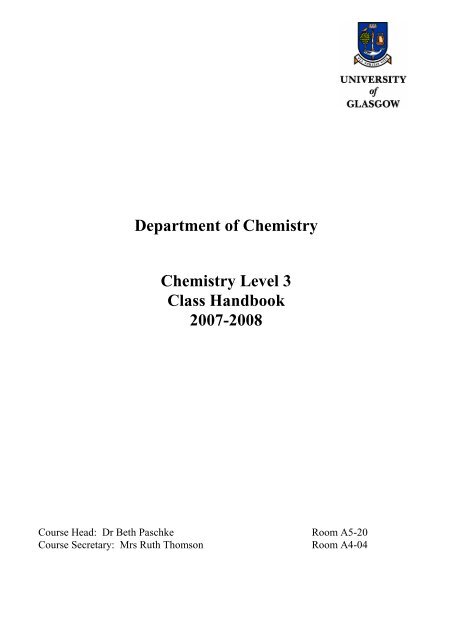
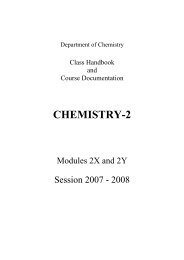

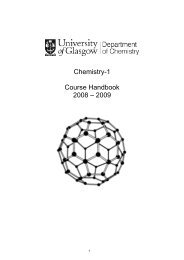
![Chemistry Study [PDF] - University of Glasgow](https://img.yumpu.com/26854063/1/184x260/chemistry-study-pdf-university-of-glasgow.jpg?quality=85)
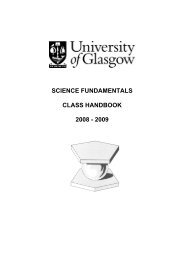

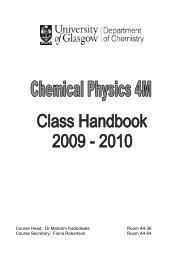
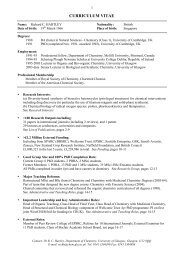
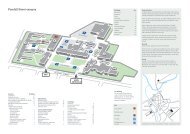
![Environmental Chemistry Study [PDF] - University of Glasgow](https://img.yumpu.com/26854018/1/184x260/environmental-chemistry-study-pdf-university-of-glasgow.jpg?quality=85)


